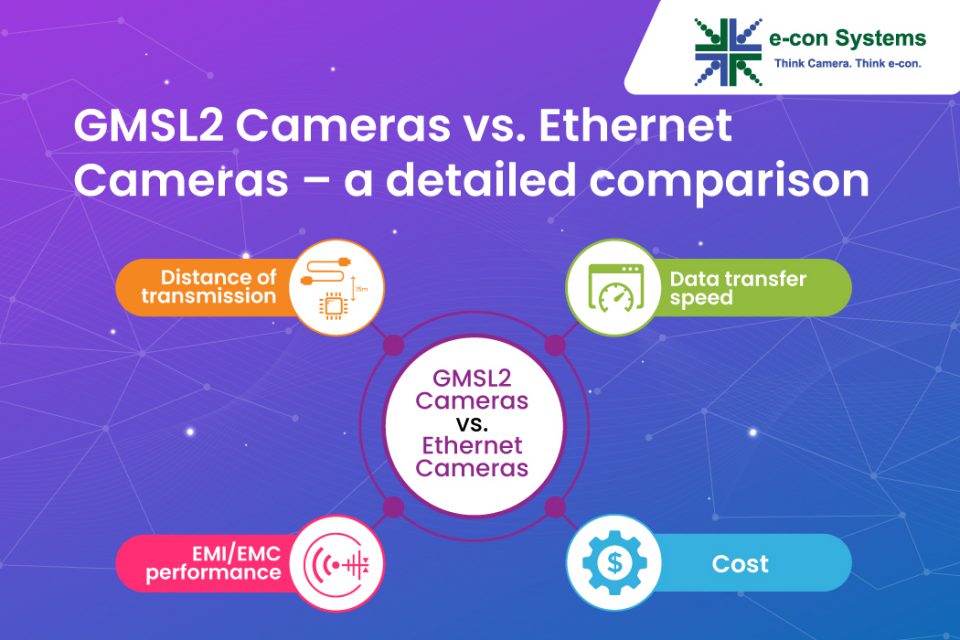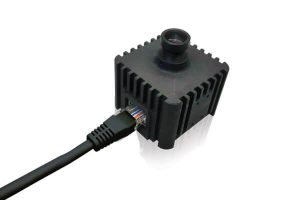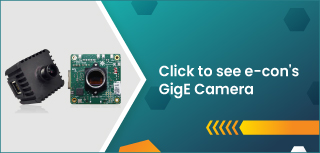Embedded cameras are now ubiquitous as a piece of technology evolving to meet the demands of today’s and tomorrow’s interconnected world. But gone are the days when the selection process was heavily dependent on the availability of even the most basic functions. Nowadays, several major factors contribute to the rise of cameras’ popularity. They include high-speed data transfer, long-range support, data integrity, and excellent image quality.
Of course, some are industry-agnostic – impacting many use cases. For instance, specific features like high-speed data transfer up to 800Gbps and long-range support up to 500m are emerging as solid goals for networking visionaries. Still, the underlying challenges required to make the next leap seem formidable. These include power, optics, architecture, and the ability of the camera to address hazardous environments.
In this article, let’s discuss how close GMSL2 and Ethernet cameras help meet these challenges to sustain the future of the embedded camera industry.
What is a GMSL2 Camera?
GMSL stands for Gigabit Multimedia Serial Link – a high-speed serial interface comprising families of serializers and deserializers. It is connected with a coaxial Shielded Twisted Pair (STP) cable or a Shielded Parallel Pair (SPP) cable. The serializer is used on the transmitter side for converting data to a serial stream. On the other hand, a deserializer on the receiving side is used for converting a serial to a parallel word for processing.
GMSL and GMSL2 cameras use the SerDes technique to carry high-speed video, bidirectional control data, and power over a single coaxial cable. They can transfer videos at a speed of up to 6Gbps per lane.
Let’s see a block diagram of an embedded system that uses the GMSL interface:
 Figure 1: GMSL SERDES System
Figure 1: GMSL SERDES System
What is an Ethernet Camera?
Before we dive deep into Ethernet cameras and how they compare to GMSL2 cameras, let’s look at why Ethernet cables are used.
What is an Ethernet Cable?
An Ethernet cable is a type of network cable consisting of an outer jacket in which copper wires are twisted around each other for the whole cable length. It is classified as an Unshielded Twisted Pair (UTP) or a Shielded Twisted Pair (STP). As the name suggests, the STP cable is provided with the shielding inside the outer jacket. This STP is commonly used in high Electromagnetic Interference (EMI) environments to mitigate data corruption.
Types of Ethernet Cables
| Category | Transmission Speed (Max) | Distance of Transmission | Shielding Type | Bandwidth (Max) |
| Cat 5e | 1Gbps | 100 meters | Unshielded | 100MHz |
| Cat 6 | 1Gbps | 100 meters | Shielded/Unshielded | 250MHz |
| 10Gbps | 55 meters | |||
| Cat 6a | 10Gbps | 55 meters | Shielded | 500MHz |
| Cat 7 | 100Gbps | 15 meters | Shielded | 600MHz |
| Cat 7a | 100Gbps | 15 meters | Shielded | 1,000MHz |
| Cat 8 | 40Gbps | 30 meters | Shielded | 2,000MHz |
Table 1: Ethernet Cable Types
An Ethernet camera captures images or records video footage and transmits it over a network via an Ethernet cable. Specifically, these cameras are preferable for embedded vision applications where reliable transmission is required over long distances. Each Ethernet camera is provided with a processing chip, which compresses the image/video footage as it is captured or recorded to avoid consuming too much bandwidth. Finally, it transmits images/video footage over the network.
Ethernet cameras are developed with the ONVIF standard – a set of open standard protocols created by surveillance industries. This standard ensures the cameras can communicate with each other and with a Network Video Recorder (NVR).
Power Over Ethernet (PoE) Technology in Ethernet Cameras
An Ethernet camera mandatorily requires both power and a network to share the recording footage or manage camera settings. So, two cable connections are needed – one with a power supply and another with a router or a switch. But if an Ethernet camera is embedded with the PoE technology, it delivers both data and DC power to devices over a single CATx Ethernet cable, without any separate power supplies.
Figure 2: GigE Camera Connected With Ethernet Cable
Transmitting data and power simultaneously using a single cable – how it works
Since Ethernet cables have twisted pairs of wires inside their outer jackets, PoE standards like IEEE 802.3af (PoE) and 802.3at (PoE+) use two twisted pairs for power and two for data. Recent PoE standard like IEEE 802.3bt (PoE++) uses all four twisted pairs for transmitting both power and data.
IEEE802.3af (PoE) – the initially developed PoE standard delivered a maximum power of 15.4 watts. A PoE camera with this standard is used for lowest power requirement applications like Wireless Access Points (WAP), Voice Over Internet Protocol (VoIP) phones, and basic surveillance cameras.
Given below are the different PoE standards:
- IEEE802.3at (PoE+) – This standard delivers a maximum power of 25.5 watts. A PoE camera with this standard supports higher power needs for devices such as VoIP cameras with LCD, surveillance cameras with enabled features like pan, tilt or zoom, and so on.
- IEEE802.3bt Type 3 (PoE++) – This standard delivers a power of 51 watts at 42.5 V -57 V. The maximum switch port power is 60 watts at 50V-57V.
- IEEE802.3bt Type 4 (PoE++) – This standard delivers a power of 71 watts at 41.1V -57V. The maximum PoE++ Type 4 switch port power is 100 watts at 52V-57V.
IEEE802.3bt PoE++ can be used for high-power applications like digital signage, information kiosk, etc.
A block diagram of e-con’s PoE camera with IEEE 802.3af compliance is shown below to demonstrate this:
Figure 3: e-con’s PoE Camera – RouteCAM
Both GMSL2 and Ethernet cameras meet the growing demands like fast data rates, high bandwidth, integrity and better EMI/EMC performances in their own ways suitable for specific applications. However, GMSL2 cameras are more advanced and are preferred for embedded vision applications that require very high speed and performance.
The parameters we will use to compare the two types of cameras are:
- Distance of transmission
- Data transfer speed
- EMI/EMC performance
- Cost
Distance of Transmission
GMSL cameras can be placed 15 meters away from the host processor through the coaxial cable or STP to operate at full speed and still support a high frame rate and less latency. So, what if the application demands more than 15 meters of cable length? The solution is a PoE camera – helpful in enabling long-distance transmission (up to 100m). For more information on cable length, please refer Table 1: Ethernet Cable Types.
To extend the Ethernet network range beyond 100m, a PoE extender is combined with a PoE camera. This combination delivers data and power to network devices up to 200m while complying with IEEE PoE and data standards. Further, the PoE extender can be cascaded to 500m. Practically, this extension is not accomplished without some trade-offs. First, the communication speed is reduced, ranging from 100 Mbps to as high as 10Gbps.
Data Transfer Speed
GMSL2 delivers excellent image quality at high data transfer speed, bandwidths, and low latency at distances up to 15m. So GMSL2 SerDes camera is preferred in embedded applications like large drones, farming equipment, and logistics robots, which require high-speed data transfer technology. On the other hand, PoE cameras can still be used for low-end requirements in devices like these. For instance, RouteCAM_CU20 – a low-light HDR PoE camera from e-con Systems – is designed for applications such as autonomous mobile robots, smart farming, smart traffic & parking lot management devices, surround-view systems, etc.
EMI/EMC Performance
Electromagnetic interference (EMI) remains a serious issue in cameras because this harmful interference affects the performance of the cable, connector, and electronic devices in the vicinity. So, to ensure the device is free from harmful interference, EMC/EMI testing is performed.
The programmable output spread spectrum capability is built into a GMSL unit’s serializer and deserializer IC to promote safety in camera applications. It improves the EMI performance of the link without the external spread-spectrum clock requirement. Also, the GMSL serializer is equipped with high-immunity mode (HIM) for robust control channel electromagnetic compatibility (EMC) tolerance.
Thus, GMSL SerDes meets the most stringent electromagnetic compatibility (EMC) requirements compared to Ethernet. At the same time, PoE or GigE cameras do meet the basic EMI/EMC requirements of majority of embedded vision applications.
Cost
PoE cameras are less expensive when it comes to new installation because it requires less cabling. Also, utilizing a PoE extender is a cost-effective way to extend the Ethernet network range beyond 100m for longer-distance applications.
On the other hand, GMSL2 cameras with coax cable require both the power and dedicated video cable running separately, resulting in more labor time and more cost for cable installation. But GMSL2 can also be powered by Power over Coax (PoC). So all the data, control signals, and power are delivered through a single coaxial cable. This enables flexible cable routing up to 15m and ease of installation in small areas.
What are the recent advancements in Ethernet & GMSL cameras?
Single Pair Ethernet (SPE) and Advanced Physical Layer (APL) are two of the most popular Ethernet innovations. Their potential benefits such as extended Ethernet cable length support and the ability to deal with hazardous environments enable a greater adoption of Ethernet in the industry. SPE uses a single twisted pair of wires, whereas other forms of Ethernet use four. SPE solutions include a robust and space-saving connector to replace the traditional RJ45 connector. It supplies data and power via a Power over Data Line (PoDL) across a single twisted pair of wires. In addition, SPE is compact, making it ideal for delivering power to small sensors, cameras, or similar miniaturized equipment. APL is an enhanced physical layer for SPE based on 10BASE-T1L.
When it comes to GMSL, GMSL3 (12Gbps) is the latest generation that transmits high frame rates (4K, 90 fps) over cable lengths of up to 14m. In addition, the GMSL3 interface supports the backward compatibility mode, meaning that its components can also be operated in GMSL2 mode.
A world-class portfolio of cameras designed by e-con Systems
e-con Systems, with close to two decades of experience in embedded vision, offers world-class GigE cameras as well as GMSL cameras. You can explore our Camera Selector page to have a look at e-con’s entire portfolio of cameras – including GMSL cameras, PoE, MIPI, USB, stereo, time of flight, and parallel cameras – all of which come with a wide variety of custom features.
If you are looking for help in integrating cameras into your products, please write to us at camerasolutions@e-consystems.com.

Prabu is the Chief Technology Officer and Head of Camera Products at e-con Systems, and comes with a rich experience of more than 15 years in the embedded vision space. He brings to the table a deep knowledge in USB cameras, embedded vision cameras, vision algorithms and FPGAs. He has built 50+ camera solutions spanning various domains such as medical, industrial, agriculture, retail, biometrics, and more. He also comes with expertise in device driver development and BSP development. Currently, Prabu’s focus is to build smart camera solutions that power new age AI based applications.








